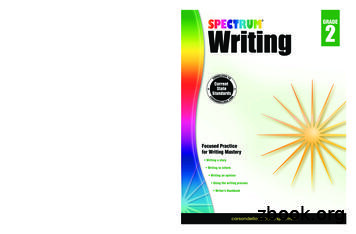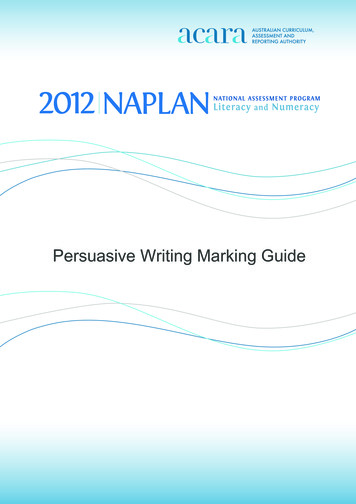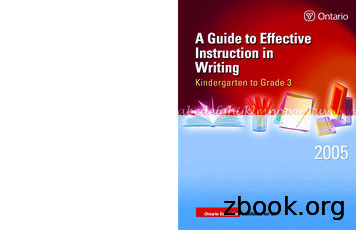Guide To Writing Policy And Procedure Documents
Guide to Writing Policy andProcedure DocumentsPreparing a policy or procedure document for UC Santa Cruz’ InfoSlug on-line policyand procedure system is not as mysterious or difficult as you might think. This guideis designed to explain the campus’ policy and procedure framework, to help policyand procedure owners organize their written documentation, and to act as a resourceas they navigate the approval process. You will find the information in this “how to”guide helpful if you are responsible for formulating or documenting new or existingpolicies and procedures.,Q 7KLV *XLGHWhy create an on-line policies and procedures system? 2Why separate policy and procedure? 3Who are the primary users of the InfoSlug policies and procedures system? 3What are the characteristics of good policies and procedure documents? 4Good policies 4Good procedures 5Writing style for policy and procedure documents 5Design and layout of policy and procedure documents 5Icon definitions 6Responsibilities of policy and procedure owners 7Templates for policy and procedure documents 8Components of policy documents 8Components of procedure documents 9Components of “roadmap” documents 10Getting started 11Policy and procedure approval checklist 12Policies 12Procedures 13Additional help 146HH OVRUniversity Policy and Procedure Formulation, Approval, and Dissemination(internal working draft dated October 28, 1994).,17(51 / :25.,1* '5 )7 ³ 3ULQWHG ² 3ROLFLHV 3URFHGXUHV 7HDP
*XLGH WR :ULWLQJ 3ROLF\ DQG 3URFHGXUH 'RFXPHQWV:K\ FUHDWH DQ RQ OLQH SROLFLHV DQG SURFHGXUHV V\VWHP"Over the past several years the campus has been actively examining its decisionmaking processes with an objective of locating decision-making authority at thelowest appropriate levels. Improvements in the campus’ process for documentingpolicies, procedures, and delegations of authority will enable this effort by addressinga number of issues:1. Ease of Access. Currently there are too many manuals and loose memos—aninformation flood. Users don’t know what is important. Policy and proceduremanuals that do exist are not always up-to-date and users cannot always find thedocuments they need to make informed decisions. An up-to-date, on-line systemwill permit those who use or are directly affected by policies and procedures tohave the access they need.2. Cost Effectiveness. Currently, individual offices must dedicate resources tomaintaining files of relevant campuswide policies and procedures. Alternatively,the offices responsible for policy must respond to requests for policy documents asthey are needed by individual users—using scarce human resources within thoseoffices which might better be assigned to other activities.Making written policies and procedures readily available and identifying a singleoffice (or position within an office) in the policy (or procedure) documents towhich questions can be directed should result in the following benefits: Less time spent on the telephone (or using electronic mail) to locate aperson to whom a question can be addressed; Fewer errors; and Consistent answers.3. Responsiveness. The ability to quickly update and disseminate procedures enablesthe campus to meet changing customer needs and to adapt to new environments.4. Accountability. Clearly written, available policies and procedures are one of thefoundation elements of any system in which individuals and units are heldaccountable for adherence to campus policies and procedures.A campus policies and procedures manual can quickly become out-of-date if aneffective policy coordination function is not coupled with the effort. The creation of aPolicy Coordinating Office responsible for the maintenance and distribution of policyrecords and up-to-date procedures along with providing guidance to you as policy(and procedure) owners will make your investment in preparing written documents amore rewarding effort.,17(51 / :25.,1* '5 )7 ³ 3ULQWHG ² 3ROLFLHV 3URFHGXUHV 7HDP
*XLGH WR :ULWLQJ 3ROLF\ DQG 3URFHGXUH 'RFXPHQWV :K\ VHSDUDWH SROLF\ DQG SURFHGXUH"Policies reflect the "rules" governing the implementation of the campus processes.Procedures, on the other hand, represent an implementation of policy and shouldevolve over time as new tools emerge, new processes are designed, and the risksassociated with an area changes in response to internal or external environmentalchanges. (In fact, there should be an expectation that individuals will “challenge”outdated procedures and call them to the attention of their owners.) As aconsequence, rather than combine “policies,” “procedures,” and “guidelines” in asingle document, it is recommended that as a general rule policies and proceduresappear as separate documents.This separation will also assist TQM (Total Quality Management) or processredesign teams in distinguishing University requirements from the existing body ofstandard practices. As the technology advances, entire manuals will be placed online. Therefore, a distinction between what is University policy and what is notbecomes very important.:KR DUH WKH XVHUV RI WKH ,QIR6OXJ SROLFLHV DQG SURFHGXUHVV\VWHP"Because the campus’ policy and procedures system is (or more precisely, will be)accessible by the entire campus community (and by off-campus users who may haveInternet access), documents must be written so that they can be understood by a wideaudience. Users of campus policy and procedure documents include individuals inboth academic and administrative offices. For example, Campus administrators, Faculty, Unit managers, Administrative support personnel, Service center staff, Teams involved in TQM or process redesign initiatives, Individuals who need to understand the “rules” by which the campus mustabide, Anyone who fills out forms and wants to generate error-free transactions, Action approvers, Support groups and volunteers,,17(51 / :25.,1* '5 )7 ³3ULQWHG ² 3ROLFLHV 3URFHGXUHV 7HDP
*XLGH WR :ULWLQJ 3ROLF\ DQG 3URFHGXUH 'RFXPHQWV Leaders of student organizations, New employees, Trainers, and Others who need to make decisions about the most effective way to carry outtheir daily tasks.Thus your efforts to make policy and procedure information widely accessible willprovide your colleagues with the tools needed to effectively move decision-making tomore appropriate levels within the campus’ organization, will help them streamlinecampus administrative processes, and will provide a basis for individual anddepartmental accountability.Of course, it will be impossible to address every aspect of policy and procedure in awritten document. Lacking information on which office to call, users could “shoparound” for answers to policy or procedure questions. In order to limit theopportunities for conflicting answers, it is important for you to designate a policy“expert” (or similarly a procedure “expert”) readily available to faculty anddepartmental administrators to interpret and to resolve problems.:KDW DUH WKH FKDUDFWHULVWLFV RI JRRG SROLFLHV DQG SURFHGXUHGRFXPHQWV"The overall goal for any policy or procedure document is for the design to be simple,consistent, and easy to use. In order to ensure a consistent format betweendocuments, the campus has developed a number of Microsoft Word templates to helpthe writers of policies and procedures get started.*RRG 3ROLFLHV Policies are written in clear, concise, simple language. Policy statements address what is the rule rather than how to implement therule. Policy statements are readily available to the campus community and theirauthority is clear. Designated “policy experts” (identified in each document) are readilyavailable to interpret policies and resolve problems. As a body, they represent a consistent, logical framework for campus action.,17(51 / :25.,1* '5 )7 ³3ULQWHG ² 3ROLFLHV 3URFHGXUHV 7HDP
*XLGH WR :ULWLQJ 3ROLF\ DQG 3URFHGXUH 'RFXPHQWV *RRG 3URFHGXUHV Procedures are tied to policies. Making explicit this relationship along withhow the procedure helps the campus achieve its goals or strategic plan helpsensure understanding and compliance. Procedures are developed with the customer/user in mind. Well developedand thought out procedures provide benefits to the procedure user. There is a sense of ownership among procedure users. For this reason, ithelps to involve users in the development of campus procedures. The procedures are understandable. Procedures should be written so thatwhat needs to be done can be easily followed by all users. When feasible, procedures should offer the user options. Procedures whichare unnecessarily restrictive may limit their usefulness.:ULWLQJ 6W\OH IRU 3ROLF\ DQG 3URFHGXUH 'RFXPHQWV Concise, minimum of verbiage. Factual—double-check accuracy! Don’t include information that may be quickly outdated (e.g., names). If you use an acronym, spell it out the first time you use it. Include step-by-step instructions for completing (paper or electronic) forms(procedures only). Not too technical—simple enough to be understood by a new employee.'HVLJQ DQG /D\RXW RI 3ROLF\ DQG 3URFHGXUH 'RFXPHQWV Generous use of white space. Presentation is structured so that the user can quickly focus on the aspect ofpolicy or procedure relevant to their decision/task at hand. Use a flexible, modular outline to make the document easy to modify (andtherefore keep up-to-date). Use labels to introduce key points (headings and labels in margins need to beconsistent . i.e., location on each page, type size, etc.).You may wish to obtain a diskette containing templates, icons, anddefined styles for headings, labels, and margins (in Microsoft Wordformat for Windows or Macintosh). These disks are available fromthe Policy Coordinating Office.,17(51 / :25.,1* '5 )7 ³3ULQWHG ² 3ROLFLHV 3URFHGXUHV 7HDP
*XLGH WR :ULWLQJ 3ROLF\ DQG 3URFHGXUH 'RFXPHQWV,FRQ 'HILQLWLRQV Icons are a useful way of pointing out critical information. The following set of icons(adapted from standards used at Stanford University) are UC Santa Cruz standards:Points the reader to information they need such as training classes,other source documents, and phone numbers of departments orindividuals who can provide assistance.Briefly states or refers reader to specific policy documents available inInfoSlug or other campus formats.Suggestions for handling a form or procedures efficiently.A critical piece of information that, if overlooked, could cause anerror.A way of doing something that is an exception to the general rule anda description of why it is an exception.A specific example of an activity, a document, etc.Explains key terms.A checklist that the user can follow to complete a task.,17(51 / :25.,1* '5 )7 ³ 3ULQWHG ² 3ROLFLHV 3URFHGXUHV 7HDP
*XLGH WR :ULWLQJ 3ROLF\ DQG 3URFHGXUH 'RFXPHQWV 5HVSRQVLELOLWLHV RI 3ROLF\ DQG 3URFHGXUH 2ZQHUV Policy and procedure “owners” are accountable for the timely review, updating, anddissemination of policies and procedures in their functional area. Assignment ofresponsibility for policies or procedures is accomplished partly through a series ofdelegations of authority. Delegations of authority assign authority and responsibilityfor actions and/or activities to specified campus administrators. Alternatively, in theabsence of a formal delegation, authority will rest with the unit which has beenassigned operational responsibility for an area.An up-to-date index to campus delegations is (or more accurately, will be) a part ofthe InfoSlug policies and procedures system.When developing new policy or revising existing policy, policy owners have anobligation to identify those who will be directly affected by new or revised policiesand to consider their views early in the policy development discussions.Similarly, when developing new or revising existing procedures, procedure ownershave an obligation to identify those who will be directly affected by new or revisedprocedures and to consider a representative sample of their views early in theprocedure development discussions. They must also ensure that their proceduresadhere to the principles of and achieve the objectives for campus process redesign,including the principles of incorporating “customer voice” and ensuring each campusprocess “adds value” to the service delivered to “customers.” For more informationabout these process redesign principles, check InfoSlug.In addition to documenting the approved policy or procedure, the owner shoulddevelop support and training options, if appropriate, for the customers/users who areattempting to adhere to their policy or procedure. This includes, at a minimum, thedesignation of “experts” to which departmental staff or faculty can turn for guidanceor to resolve problems.For more information (or for a copy of the full written policy concerning “owner”responsibilities), check the InfoSlug policies and procedures system (when it becomesavailable) or contact the Policy Coordinating Office.,17(51 / :25.,1* '5 )7 ³3ULQWHG ² 3ROLFLHV 3URFHGXUHV 7HDP
*XLGH WR :ULWLQJ 3ROLF\ DQG 3URFHGXUH 'RFXPHQWV7HPSODWHV IRU SROLF\ DQG SURFHGXUH GRFXPHQWV &RPSRQHQWV RI 3ROLF\ 'RFXPHQWV Campus policy documents should use a paragraph numbering system that permitsthem to be cited easily and they should include each of the following components:1.Headline bannerUC Santa Cruz Policy, the policy title, issuing date, and an identificationblock which includes: Policy number, Page Number, Effective Date,“Supersedes” notification, Office of Origin, and Policy Approval Authority.The Policy Number and Page Number would appear on all subsequentpages; the footer of each page should repeat the Issuing Date and the PolicyTitle.Note: The policy title should be carefully selected so that it is simple andclearly conveys the policy’s content.2.Purpose of the policy/Policy statementA concise statement of the rationale for the policy, including if appropriate,reference to external regulations, further policy discussion, etc. Summary(one paragr
Preparing a policy or procedure document for UC Santa Cruz’ InfoSlug on-line policy and procedure system is not as mysterious or difficult as you might think. This guide is designed to explain the campus’ policy and procedure framework, to help policy and procedure owners organize their written documentation, and to act as a resource
work/products (Beading, Candles, Carving, Food Products, Soap, Weaving, etc.) ⃝I understand that if my work contains Indigenous visual representation that it is a reflection of the Indigenous culture of my native region. ⃝To the best of my knowledge, my work/products fall within Craft Council standards and expectations with respect to
Academic Writing Quiz xvii Part 1 The Writing Process 1 1.1 Background to Writing 3 The purpose of academic writing 3 Common types of academic writing 4 The format of long and short writing tasks 4 The features of academic writing 6 Some other common text features 6 Simple and longer sentences 7 Writing in paragraphs 8 1.2 Reading: Finding .
Best Practice Book for IELTS Writing. Table of Contents IELTS Writing 1 IELTS Writing 9 IELTS Writing - Overview 9 IELTS Academic Writing 10 IELTS ACADEMIC WRITING 10 IELTS General Writing 11 IELTS Writing Task General (Task 1) 12 Sample 1 12 Sample 2 12 Sample 3 13 Sa
(CCSS) for Writing, beginning in early elementary, will be able to meet grade-level writing goals, experience success throughout school as proficient writers, demonstrate proficiency in writing to earn an Oregon diploma, and be college and career-ready—without the need for writing remediation. The CCSS describe ―What‖ writing skills students need at each grade level and K-12 Writing .
Writing Spectrum is available in these titles for second grade success: Carson-Dellosa Publishing LLC P.O. Box 35665 Greensboro, NC 27425 USA carsondellosa.com SPECTRUM Writing GRADE 2 Focused Practice for Writing Mastery Writing a story Writing to inform Writing an opinion
Oracle Policy Modeling User's Guide (Brazilian Portuguese) Oracle Policy Modeling User's Guide (French) Oracle Policy Modeling User's Guide (Italian) Oracle Policy Modeling User's Guide (Simplified Chinese) Oracle Policy Modeling User's Guide (Spanish) Structure Path Purpose Program Files\Oracle\Policy Modeling This is the default install folder.
Assessing Writing in the National Assessment Program The NAPLAN writing task The writing task for the 2012 writing assessment is a persuasive writing task. It is the same task for all students in Years 3, 5, 7 and 9. The writing task is provided to the students on a full-colour stimulus sheet. It contains the topic, task
This guide has seven chapters. Chapter 1 provides an overview of effective writing instruction. Subsequent chapters address the five key instructional approaches of an effective writing program: modelled writing, shared writing, interactive writing, guided writing, and independent writing























